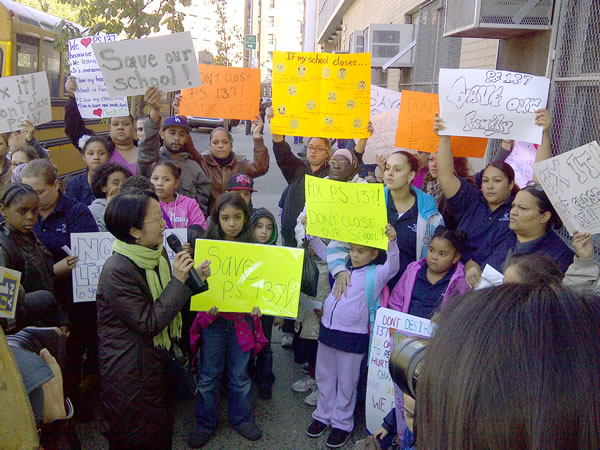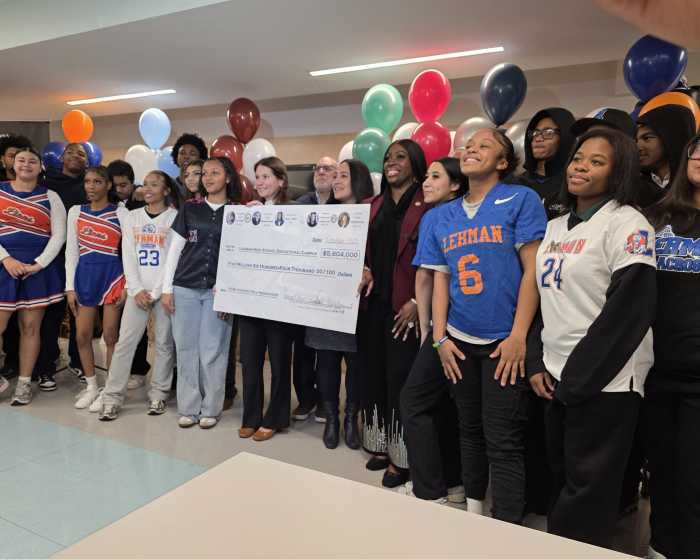By Aline Reynolds
Lower East Side parents are desperately fighting to keep their local public school open now that it’s potentially on the chopping block after recently getting a failing performance grade from the Department of Education.
P.S. 137, a K-to-5 school at 293 East Broadway, received an “F” grade in its 2010-’11 school year progress report — a significant drop from its “C” score in the 2009-’10 year and “A” score in 2008-’09.
As a result, the school has been classified as “needing further examination and review” by the Department of Education due to its poor performance. A department-issued school evaluation will be released in December — after which, D.O.E. will announce which schools it will be closing, by phasing them out.
P.S. 137 is the only public school in Manhattan south of 14th St. currently categorized as “struggling,” according to D.O.E. data.
The department evaluates schools based on current and former enrollment trends, community needs, leadership and teacher performance, current and past test scores, and school environment, according to Frank Thomas, a D.O.E. spokesperson.
“We are engaging the community, parents and elected officials as part of our work to find out what is working and what isn’t in these schools, and will take that all into account before making any decisions,” Thomas said.
Nevertheless, P.S. 137’s parents and administrators fear the department’s evaluation could be the beginning of the end for the formerly “A”-rated school.
“I’m upset. I’ve got a feeling it’s going to be closed,” said Maria Diaz, the school’s Parent-Teacher Association president. A resident of the LaGuardia Houses, a nearby public housing development, she has three grandchildren in the school.
Diaz has devised a contingency plan for her family — looking into other Lower East Side schools, such as P.S. 20 and The Earth School, as alternative options for her grandkids.
“Like I told my daughter — if it’s going to be an issue, we have to prepare ourselves for what’s going to happen to their future,” Diaz said.
A school staffer, who requested anonymity for fear of D.O.E. retaliation, faulted the department for not providing adequate support to the school during a difficult transition period.
“To go from an ‘A’ to an ‘F’…you’d really have to be sitting around twirling your thumbs all day for that to happen,” she said. “That’s not the kind of school we are.”
P.S. 137 was particularly vulnerable to poor student performance in the last year, according to the source — due in part to losing one-quarter of its 20-member staff, because of retirement and other attrition, midway through the 2009-’10 school year.
Many of the educators were replaced by substitutes rather than full-time teachers, according to sources.
Retaining the teachers was “crucial” to the school’s success, according to the staffer.
“When you have a substitute, they’re not mandated to follow the standards we have,” she explained. Instead, she said, the baseline standard becomes: “As long as the kids don’t kill themselves or each other, then we’re good.”
Other factors led to the school’s recent performance downfall, according to the source, such as a budget shrinkage by $350,000 in recent years and the loss of the school’s after-school enrichment program, “Virtual Y.”
Asked about the school’s recent slump, Diaz said she lays most of the blame on the state English Language Arts and math exams, which third-through-eighth graders are required to take each school year. The exam’s gradual switch of focus from multiple choice to written-answer questions has proven difficult for the elementary students, she said.
Diaz’s own granddaughter, fifth grader Kathleen Perez, complained this year about math being especially grueling, and received a “3” score last year in her math and English exams — compared to a “4” score two years ago. (A “4” is considered excellent and a “3” somewhere near average.)
“I’m not blaming the principal. I’m not blaming the students,” said Diaz. “These are hard tests for them, and they’re getting harder. They should make it more simple for them to understand.”
Asked for comment about the exams’ level of difficultly, Matthew Mittenthal, a D.O.E. spokesperson, said the city department backs the state Department of Education’s effort to make the exams more challenging — and, specifically, more geared toward honing students’ critical thinking skills.
“It’s the only way we are going to prepare our kids for college-level work,” Mittenthal said.
P.S. 137 Principal Melissa Rodriguez couldn’t be reached for comment by press time.
In an Oct. 25 letter to Schools Chancellor Dennis Walcott, Councilmember Margaret Chin expressed her support for P.S. 137, and attributed the school’s 2010-’11 failing performance grade to factors outside its control.
“Recently, I have met with Principal Rodriguez, members of the P.T.A. and parent coordinators, as well as visited the school,” Chin wrote. “I do not believe the ‘F’ grade is an accurate representation of student achievement at P.S. 137.
“Under no circumstances should P.S. 137 be considered for phase-out.”
In 2006, the school was transferred from Cherry St. to its current building at East Broadway, which it shares with P.S. 134. Since then, the school has had difficulties “establishing an identity at its current location,” according to Chin. The two schools are forced to share classrooms, a library and even administrative office space. P.S. 137 doesn’t have its own entrance to the building, the councilmember noted.
“The exterior of the building is inscribed with only the name of P.S. 134, despite requests by Principal Rodriguez for equal signage,” Chin noted.
In fact, according to the anonymous staffer, P.S. 134 hasn’t been welcoming to P.S. 137, and is treating the new school as a “guest” rather than a “neighbor.”
“They would be happy to roll out the red carpet for us to get out,” she said.
In addition to having a sizeable minority and public housing demographic, P.S. 137 boasts an unusually high number of English Language Learners — 18 percent total, compared to an average of 13 percent in other similarly ranked city public schools.
According to Chin and other school advocates, these students, whose native language isn’t English, are “under-weighted” in comparison to special-needs, free-lunch and minority students — which, they contend, has a direct bearing on the school’s progress report. And, the staffer pointed out that, according to statewide policy, E.L.L. students are required to take the same exams as native-English-speaking children after only one year of being in a city public school.
“Whatever language skills we build Monday through Friday get broken down on nights and weekends,” she said, since the students’ families speak to them in their native languages.
School parents organized a rally on Tues., Oct. 25, to build support for the school. Another rally will be held in front of the school on Mon., Nov. 14.






































